17 Goals To Transform The Pacific
17 Sustainable Development Goals in the Pacific Dashboard
This SDG Dashboard is the regional dissemination platform for the 16 Pacific Island Countries and Territories which are members of the Pacific Islands Forum. It holds data on the 132 Pacific Sustainable Development Indicators selected by the region and endorsed by Forum Leaders in the Pacific Roadmap for Sustainable Development, and will enable monitoring of progress against the 2030 Agenda for Sustainable Development.
Data is being collated from a number of sources, including national household census and survey collections, civil registry data, health information systems, education management information systems, treasury papers, satellite data, custodian agency data and published reports from countries and development partners.
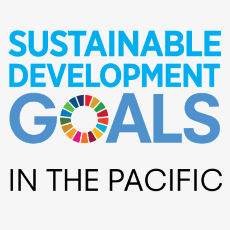
- ...
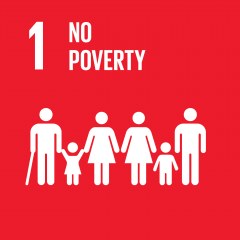
-
SDG 1 - No Poverty
End poverty in all its forms everywhere.
Poverty in the Pacific is focused on hardship and lack of economic opportunity and social exclusion. While food and extreme poverty remains relatively low, an estimated one in four Pacific islanders are likely to be living below their country’s basic-needs poverty line (BNPL). Children are especially vulnerable to poverty and inequality because of their dependency on adults for care and protection, and for food. Deprivation and lost opportunities in childhood can have detrimental effects that may persist throughout a child’s life. If a child does not receive adequate nutrition, stunting may result, and intellectual development may be impaired. Poorly nourished children are more vulnerable to disease, tend to perform worse in school, and less likely to be productive adults.
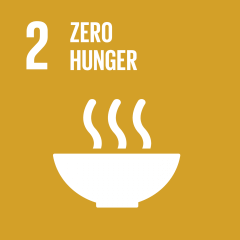
-
SDG 2 - Zero Hunger
End hunger, achieve food security and improved nutrition and promote sustainable agriculture
Stunting, which can occur when a child under five years of age and does not receive adequate nutrition, remains an issue in some of our Pacific countries. One in four children in Vanuatu, one in three children in the Solomon Islands and one in two children in PNG are reported as being stunted. Poorly nourished children are more vulnerable to disease, tend to show lower performance in school, and are less likely to be productive adults.
At the same time, the prevalence of obesity in young children is increasing in parts of the region, although there is insufficient data to give a complete picture. 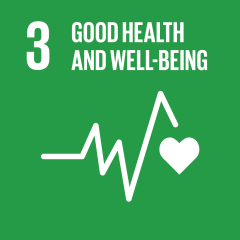
-
SDG 3 - Good Health And Well-Being
Ensure healthy lives and promote well-being for all at all ages
Some progress has been made against key mortality measures. Maternal mortality ratios have already fallen below the 2030 target in three-quarters of Pacific countries and territories, and one-half have achieved the under-five mortality rate target of fewer than 25 deaths per 100,000.
The increasing burden of non-communicable diseases, both with respect to the risk of premature mortality and health care costs, is the dominant health issue in the Pacific region. A mixed pattern is found in the two lifestyle risk factors of alcohol and smoking, with three Pacific countries featuring among the top ten world countries in prevalence of current tobacco use among persons aged 15 years and older.
Health worker density remains below WHO guidelines in most countries in the region.
Malaria is still present in three countries (PNG, Solomon Islands and Vanuatu), although the incidence is decreasing due to awareness and preventative measures.
.
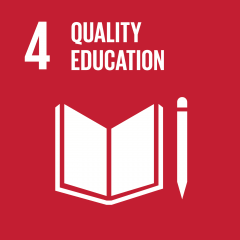
-
SDG 4 - Quality Education
Ensure inclusive and equitable quality education and promote lifelong learning opportunities for all
Access to education has improved, shown through increased attendance levels in early childhood, primary and secondary school in the Pacific region. Goal 4 highlights the need to focus on improving the quality and relevance of education and cognitive learning outcomes, since literacy and numeracy improvements have not made the expected gains for all. There is also a renewed focus on lifelong learning with early childhood care education and post-secondary education and training needing priority attention.
The quality of educational facilities in some countries in the region, especially for girls and students with disabilities, is below standard.
.
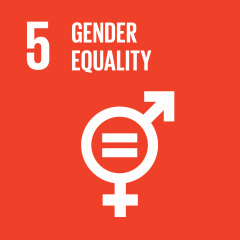
-
SDG 5 - Gender Equality
Achieve gender equality and empower all women and girls
The region has made some progress toward achieving gender equality and empowering women and girls, particularly in education and health and to a lesser extent women’s participation in formal employment and national policy making. This is attributed to growing awareness of the need to address gender inequalities.
While almost all countries in the Pacific have adopted specific gender policies and strategies, the resources for integrating and implementing these priorities are limited. Budgets for national women’s offices are less than one percent of national appropriations.
Gender inequality is highlighted by the high prevalence rates of violence against women (more than 60 percent in Melanesia, and more than 40 percent in Polynesia and Micronesia). Sexual and reproductive health and rights issues also remain substantial challenges to be addressed under Goal 5. Fertility rates, especially teenage fertility, remain high in some parts of the region.
The Pacific Roadmap on Gender Statistics (2019) supports Pacific National Statistical Systems to generate gender data that meets users' needs to advance gender equality.
.
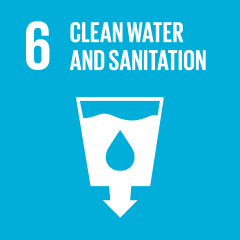
-
SDG 6 - Clean Water and Sanitation
Ensure availability and sustainable management of water and sanitation for all
Water and sanitation coverage in the Pacific is low, and accessibility varies widely across, and between, Pacific countries and territories. The combined coverage levels of basic water and basic sanitation are lower than in any other region in the world, and nearly one-third of Pacific people still rely on surface water sources for drinking (largely due to the high reliance of surface water in rural PNG).
Children and their families are most vulnerable to the WASH-related impacts of climate change.
.
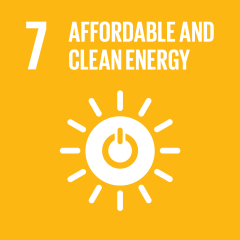
-
SDG 7 - Affordable And Clean Energy
Ensure access to affordable, reliable, sustainable and modern energy for all
The following Pacific priority actions relate to Goal 7: a) reaching universal access to energy; b) increasing the share of renewables in the energy mix; c) energy efficiency measures in the transport, industry, and building sectors; d) institutional, legislative and regulatory reforms in the energy sector; e) collecting, centralizing, analysing and disseminating energy-related data and policy relevant information.
Several countries have reported increases in the share of population accessing electricity over the last decade, with the increase in national electrification levels largely coming from household access to off-grid systems such as photovoltaic solar home systems. Many countries have achieved, or are close to achieving, universal access to electricity, resulting in gains in the average electrification rate in the region. In PNG, Vanuatu and the Solomon Islands however, there remain significant gaps in electricity and/or fossil fuel access.
Some low-income households still use little petroleum fuel or electricity due to high costs, even though these can be easily accessed.Given the potential impact, overall energy efficiency investments at the national level appear more attractive than renewable energy but have generally not been a priority of countries nor development partners.
.
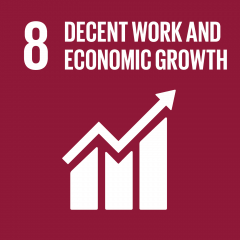
-
SDG 8 - Decent Work and Economic Growth
Promote sustained, inclusive and sustainable economic growth, full and productive employment and decent work for all
Overall, economic trends in the Pacific region have been positive, yet inconsistent. The restricted economic bases of Pacific Island countries are highly sensitive to external economic shocks (including commodity price fluctuations, supply chain disruptions and financial stress), natural events (such as cyclones, floods and droughts) and costs of adaptation to climate change.
Internal employment factors in the Pacific compound these external factors. The size of the informal economy; gender gaps and imbalances; and high youth unemployment/underemployment are issues that can be monitored under Goal 8.Tourism is an important sector of growth and development in the Pacific, providing foreign exchange earnings, employment and income earning opportunities for many Pacifc islanders. Tourism is one of the region’s few economically viable sectors, and its share in national GDPs is monitored in this goal.
.
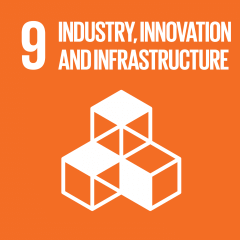
-
SDG 9 - Industry, Innovation And Infrastructure
Build resilient infrastructure, promote inclusive and sustainable industrialization and foster innovation
Information and communications technology can mitigate the challenges of distance and isolation. Individual use of mobile phone technology is generally widespread, although the technology available varies significantly across the region.
Manufacturing can be a key promoter of economic development and employment. In most Pacific countries however, formal employment in manufacturing remains low and value added manufacturing a small share of GDP
.
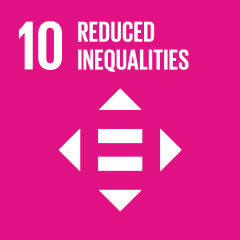
-
SDG 10 - Reduced Inequalities
Reduce inequality within and among countries
Pacific SIDS require special assistance to guarantee a share in the benefits of sustainable development. Their role in international organisations, with respect to membership and voting rights, is one element in this process.
Goal 10 also seeks to measure inequality within countries, by looking at the change in per capita income or consumption of the poorest four-tenths of the population relative to the national average.
.
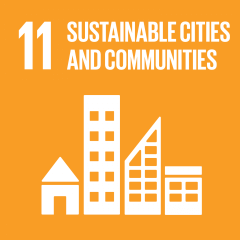
-
SDG 11 - Sustainable Cities and Communities
Make cities and human settlements inclusive, safe, resilient and sustainable
The 2017 World Risk Report identified the Pacific as the region of highest risk, measured over a five-year timeframe.
In the last three years, the Pacific has faced a number of disaster events causing significant economic impacts, injury and loss of life. Post-disaster needs assessments indicated significant damages and losses, equivalent to 30% of national GDP in Fiji (2016), and 64% in Vanuatu (2015) for example.
The quality of housing, the existence of urban slums, and waste management practices will also be addressed in Goal 11. The estimated waste generation for the region’s urban population is 1.16 million tonnes in 2013, a level projected to increase to over 1.59 million tonnes by 2025.
.
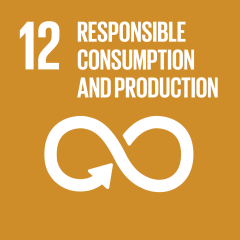
-
SDG 12 - Responsible Consumption and Production
Ensure sustainable consumption and production patterns
Inadequate waste management practices and restricted land availability are contributing to increased volumes of solid and hazardous wastes in the region.
Organic waste constitutes approximately 44 per cent of the waste stream, and over 80 percent of ocean litter is derived from land-based sources.
There is currently limited data on recycling rates and hazardous waste treatment in the Pacific, although these are identified as priorities for sustainable development.
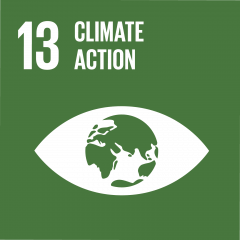
-
SDG 13 - Climate Action
Take urgent action to combat climate change and its impacts
Climate change is a critical development challenge for the region. The key threats are sea level rise, saltwater intrusion of freshwater lenses and ocean acidification and their impact on people, water and food security, livelihoods, and the Pacific region’s biodiversity and culture. Climate induced mobility and migration across the region may be a required adaptation strategy.
Goal 13 indicators still require development for effective monitoring to take place.
.
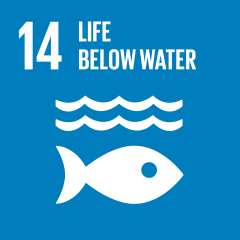
-
SDG 14 - Life Below Water
Conserve and sustainably use the oceans, seas and marine resources for sustainable development
The Blue Pacific continent contains and supports the most extensive and diverse coral reefs in the world, the largest tuna fishery, the deepest oceanic trenches and the healthiest and in some cases, largest remaining populations of many globally threatened species such as whales and dolphins, sea turtles, dugongs, sharks and stingrays.
Goal 14 will monitor regional efforts in integrated and sustainable ocean management and conservation, adaptation, mitigation and biodiversity activities.
.
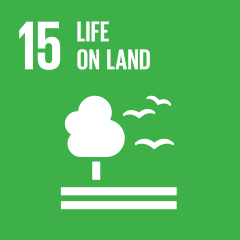
-
SDG 15 - Life on Land
Protect, restore and promote sustainable use of terrestrial ecosystems, sustainably manage forests, combat desertification, and halt and reverse land degradation and halt biodiversity loss
Most countries in the region retain sizeable sections of forested area, although habitat loss continues to be a risk due to unsustainable logging practices and forest conversion for plantation and agricultural uses. Invasive species are the leading cause of species extinction on island ecosystems and can impact food and economic security. A regionally co-ordinated response is in place for the management of invasive species in the Pacific.
Ecosystem-based approaches are being integrated into national and sector plans, with potential benefits including enhanced livelihood opportunities and food security; increased biodiversity conservation; and improved carbon sequestration and sustainable water management. The Red List Index, is an indicator of changes in biodiversity and species extinction risk over time.
.
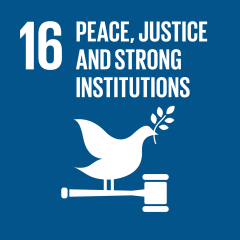
-
SDG 16 - Peace, Justice and Strong Institutions
Promote peaceful and inclusive societies for sustainable development, provide access to justice for all and build effective, accountable and inclusive institutions at all levels
The inclusiveness and transparency of institutions is addressed in Goal 16, although defining and measuring this is difficult. Associated with this is the adoption of legislation or policies to guarantee freedom of information, and while adoption is low in the Pacific, awareness is increasing.
Birth registration is necessary to safeguard individual rights and promote access to justice and social services. The Pacific region has seen improved levels of registration of children under five years due to co-ordinated regional efforts under the Brisbane Accord Group (BAG).
Violence in all its forms, and the official reporting of violence to competent authorities, is also a component of Goal 16. There is currently limited data to report on.
.
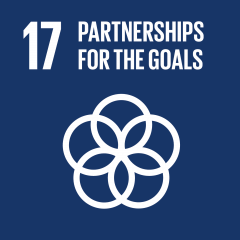
-
SDG 17 - Partnerships for the Goals
Strengthen the means of implementation and revitalize the Global Partnership for Sustainable Development Finance
Goal 17 encapsulates the need for a transformational approach to development if prosperity, equality for all and a protected environment, are to be achieved. This includes harnessing policy coherence, developing multi-stakeholder partnerships, accessing public and private finance, durable trading relationships, effective adoption of science and technology, and improving collection and use of data.
While understanding that Pacific countries are responsible for their own sustainable development, addressing many sustainable development challenges requires enhanced cooperation and international support. ODA and other external development financing streams remain significant in many countries.
The integration of the SDGs into national and regional planning and budgeting brings an unprecedented demand for data and information. The strength and development of national statistical systems is covered in Goal 17.
.
These SDG Progress Wheels provide an effective means of quickly visualising target progress through the Pacific. The wheels should be read as follows:
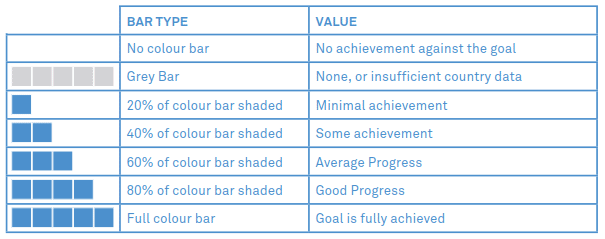
Notes
- All indicators presented in this dashboard reference the official United Nations SDG indicator list. Any Pacific variations are mentioned alongside the respective indicators in this dashboard.
- SDGs in the Pacific Booklet details the 132 indicators selected for Pacific regional reporting. Please note that one of the 132 indicators was removed from the UN SDG list in 2020 due to difficulties in establishing a methodology.
- These progress wheels were designed by SPC and UNDP to supplement the Pacific's 1st Quadrennial Report on Sustainable Development. They have been adapted, with permission, from a design originally conceived by OECD.